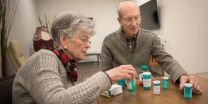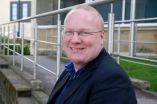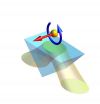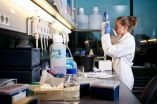(Press-News.org) This news release is available in French.
Gallery owners, private collectors, conservators, museums and art dealers face many problems in protecting and evaluating their collections such as determining origin, authenticity and discovery of forgery, as well as conservation issues. Today these problems are more accurately addressed through the application of modern, non-destructive, "hi-tech" techniques.
Dmitry Gavrilov, a PhD student in the Department of Physics at the University of Windsor (Windsor, Canada), along with Dr. Roman Gr. Maev, the Department of Physics Professor at the University of Windsor (Windsor, Canada) and Professor Dr. Darryl Almond of the University of Bath (Bath, UK) have been busy applying modern techniques to this age-old field. Infrared imaging, thermography, spectroscopy, UV fluorescence analysis, and acoustic microscopy are among the innovative approaches they are using to conduct pre-restoration analysis of works of art. Some fascinating results from their applications are published today in the Canadian Journal of Physics.
Since the early 1900s, using infrared imaging in various wave bands, scientists have been able to see what parts of artworks have been retouched or altered and sometimes even reveal the artist's original sketches beneath layers of the paint. Thermography is a relatively new approach in art analysis that allows for deep subsurface investigation to find defects and past reparations. To a conservator these new methods are key in saving priceless works from further damage.
Gavrilov explains, "We applied new approaches in processing thermographic data, materials spectra data, and also the technique referred to as craquelure pattern analysis. The latter is based on advanced morphological processing of images of surface cracks. These cracks, caused by a number of factors such as structure of canvas, paints and binders used, can uncover important clues on the origins of a painting."
"Air-coupled acoustic imaging and acoustic microscopy are other innovative approaches which have been developed and introduced into art analysis by our team under supervision of Dr. Roman Gr. Maev. The technique has proven to be extremely sensitive to small layer detachments and allows for the detection of early stages of degradation. It is based on the same principles as medical and industrial ultrasound, namely, the sending a sound wave to the sample and receiving it back. "
Spectroscopy is a technique that has been useful in the fight against art fraud. It can determine chemical composition of pigments and binders, which is essential information in the hands of an art specialist in revealing fakes. As described in the paper, "…according to the FBI, the value of art fraud, forgery and theft is up to $6 billion per year, which makes it the third most lucrative crime in the world after drug trafficking and the illegal weapons trade."
One might wonder how these modern applications can be safe for delicate works of art when even flash photography is banned in art galleries. The authors discuss this and other safety concerns, describing both historic and modern-day implications of flash bulbs and exhibit illumination and scientific methods. As the paper concludes, the authors suggest that we can expect that the number of "hi-tech" techniques will only increase. In the future, art experts will likely have a variety of tools to help them solve many of the mysteries hiding beneath the layers.
INFORMATION:
The article titled "A review of imaging methods in analysis of works of art. Thermographic imaging method in art analysis." by D. Gavrilov, R. Gr. Maev, and D. P. Almond is published today in the Canadian Journal of Physics.
The paper is accompanied by illuminating images of a range of real canvas and panel paintings found in museums and in private collections on which they applied their techniques.
The full study is available at http://nrcresearchpress.com/doi/abs/10.1139/cjp-2013-0128#.UxdoooVh2FA
DOI: dx.doi.org/10.1139/cjp-2013-0128
When art and science collide -- the masterpiece unmasked
Physicists uncover secrets hidden beneath the surface of great works of art
2014-03-06
ELSE PRESS RELEASES FROM THIS DATE:
Half the survivors in 1 Japanese town have PTSD symptoms
2014-03-06
Though just two of Hirono's 5,418 residents lost their lives in Japan's mega-earthquake and tsunami, a new study shows that the survivors are struggling to keep their sanity.
One year after the quake, Brigham Young University professor Niwako Yamawaki and scholars from Saga University evaluated the mental health of 241 Hirono citizens. More than half of the people evaluated experienced "clinically concerning" symptoms of post-traumatic stress disorder. Two-thirds of the sample reported symptoms of depression.
Those rates exceed levels seen in the aftermath of other ...
Heart failure unknowns a roadblock to managing health
2014-03-06
Al Brommeland found a true partner in his wife Florence. Through 57 years of marriage they've proved a formidable team, swinging and bowing at square dances, kicking up dust in their clogs, and now in their golden years, taking daily strolls side by side.
When Al started experiencing irregular heart rhythm 12 years ago, the couple worked together to stay healthy. It hasn't been easy, both in terms of symptoms—emergency doctors stopped and restarted Al's heart eight times over the years—or finding answers to their questions about how to best manage his illness, recently ...
UCLA engineering team increases power efficiency for future computer processors
2014-03-06
Have you ever wondered why your laptop or smartphone feels warm when you're using it? That heat is a byproduct of the microprocessors in your device using electric current to power computer processing functions — and it is actually wasted energy.
Now, a team led by researchers from the UCLA Henry Samueli School of Engineering and Applied Science has made major improvements in computer processing using an emerging class of magnetic materials called "multiferroics," and these advances could make future devices far more energy-efficient than current technologies. ...
LSUHSC mental health care model reduced symptoms in those most affected by BP oil spill
2014-03-06
New Orleans, LA – A model of care developed by the Department of Psychiatry at LSU Health Sciences Center New Orleans School of Medicine to provide mental health services after the Deepwater Horizon Gulf Oil Spill reduced both mental health and general medical symptoms. The novel approach embedded psychiatrists, psychologists, social workers and telemedicine resources into primary care clinics in the most affected areas. This new model can be used in communities at risk for disasters and rural communities with limited mental health resources. The initiative is featured ...
Collecting digital user data without invading privacy
2014-03-06
This news release is available in German.
The statistical evaluation of digital user data is of vital importance for analyzing trends. But it can also undermine the privacy. Computer scientists from Saarbrücken have now developed a novel cryptographic method that makes it possible to collect data and protect the privacy of the user at the same time. They present their approach for the first time at the computer expo CeBIT in Hannover at the Saarland University research booth (hall 9, booth E13).
"Many website providers are able to collect data, but only a few manage ...
Hudds researchers call for major 'de-escalation' survey within the NHS
2014-03-06
VERBAL and physical aggression towards health and social care staff is on the increase. The NHS has reported a rise of 5.8 per cent in reported assaults – up to 63,199 in 2012/13. Now a University of Huddersfield lecturer has called for a programme of research to establish the best methods for dealing with the problem.
Various techniques known as "de-escalation" have evolved in order to calm threatening situations. But there is a lack of solid evidence to identify the most successful approaches, according to Dr Andrew Clifton, a former community psychiatric nurse who ...
Extraordinary momentum and spin discovered in evanescent light waves
2014-03-06
A team of researchers from the RIKEN Center for Emergent Matter Science (CEMS) in Japan has identified unexpected dynamic properties of a type of light wave called evanescent waves. These surprising findings contrast sharply with previous knowledge about light and photons.
The study carried out in the Quantum Condensed Matter Research Group (CEMS, RIKEN, Japan) led by Dr. Franco Nori is published today in the journal Nature Communications.
Energy, momentum, and angular momentum are the main dynamic characteristics of physical objects. It is well known that light propagating ...
Love or kill thy neighbor? New study into animal social behavior
2014-03-06
A theoretical study led by the University of Exeter has shed new light on the conditions that lead to the evolution of spite or altruism in structured populations.
Understanding the way in which social behaviours such as altruism – when animals benefit others at their own expense – develop is a long-standing problem that has generated thousands of articles and heated debates.
Dr Florence Débarre of Biosciences at the University of Exeter led a study, published today in Nature Communications, which presents a comprehensive framework that applies to a large class of population ...
Enzyme controls transport of genomic building blocks
2014-03-06
Our DNA and its architecture are duplicated every time our cells divide. Histone proteins are key building blocks of this architecture and contain crucial information that regulates our genes. Danish researchers show how an enzyme controls reliable and high-speed delivery of histones to DNA copying hubs in our cells. This shuttling mechanism is crucial to maintain normal function of our genes and prevent disease. The results are published in the journal Nature Communications.
Interdisciplinary research team finds cellular high-speed shuttle
An interdisciplinary team ...
The Spectrum IFA Groups Expands in Madrid, Spain
2014-03-06
The Spectrum IFA Group are delighted to announce that Conor MacSherry has joined Paul Bristow and Chris Webb in the Madrid office.
Conor has worked in Financial Services for 27 years covering all aspects of protection, mortgages, investment and retirement planning. Through many years of management roles covering sales, development, compliance and consultancy, Conor has always maintained his authorisation to deal with and look after his clients directly.
As well as being a fully qualified Financial Adviser, Conor holds a B.A. Degree in Business Studies, a Diploma ...
LAST 30 PRESS RELEASES:
Can community awareness campaigns in low-resource areas improve early diagnosis of colorectal cancer?
Stardust study resets how life’s atoms spread through space
Practical education: Clinical scenario-based program development
The impact of family dynamics on eating behaviour – how going home for Christmas can change how you eat
Tracing the quick synthesis of an industrially important catalyst
New software sheds light on cancer’s hidden genetic networks
UT Health San Antonio awarded $3 million in CPRIT grants to bolster cancer research and prevention efforts in South Texas
Third symposium spotlights global challenge of new contaminants in China’s fight against pollution
From straw to soil harmony: International team reveals how biochar supercharges carbon-smart farming
Myeloma: How AI is redrawing the map of cancer care
Manhattan E. Charurat, Ph.D., MHS invested as the Homer and Martha Gudelsky Distinguished Professor in Medicine at the University of Maryland School of Medicine
Insilico Medicine’s Pharma.AI Q4 Winter Launch Recap: Revolutionizing drug discovery with cutting-edge AI innovations, accelerating the path to pharmaceutical superintelligence
Nanoplastics have diet-dependent impacts on digestive system health
Brain neuron death occurs throughout life and increases with age, a natural human protein drug may halt neuron death in Alzheimer’s disease
SPIE and CLP announce the recipients of the 2025 Advanced Photonics Young Innovator Award
Lessons from the Caldor Fire’s Christmas Valley ‘Miracle’
Ant societies rose by trading individual protection for collective power
Research reveals how ancient viral DNA shapes early embryonic development
A molecular gatekeeper that controls protein synthesis
New ‘cloaking device’ concept to shield sensitive tech from magnetic fields
Researchers show impact of mountain building and climate change on alpine biodiversity
Study models the transition from Neanderthals to modern humans in Europe
University of Phoenix College of Doctoral Studies releases white paper on AI-driven skilling to reduce burnout and restore worker autonomy
AIs fail at the game of visual “telephone”
The levers for a sustainable food system
Potential changes in US homelessness by ending federal support for housing first programs
Vulnerability of large language models to prompt injection when providing medical advice
Researchers develop new system for high-energy-density, long-life, multi-electron transfer bromine-based flow batteries
Ending federal support for housing first programs could increase U.S. homelessness by 5% in one year, new JAMA study finds
New research uncovers molecular ‘safety switch’ shielding cancers from immune attack
[Press-News.org] When art and science collide -- the masterpiece unmaskedPhysicists uncover secrets hidden beneath the surface of great works of art





